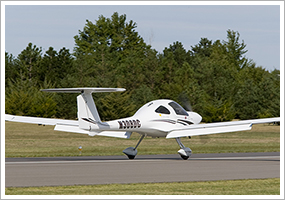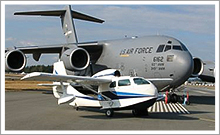This is the August 27, 2010, issue of 'AOPA ePilot: Flight Training Edition'
| ||||
| | FT News | INSIDE AOPA | TRAINING PRODUCTS | FINAL EXAM | |||
TRAINING TIPsTouchdown tolerances
So here’s a related question: What aim point did you choose for that nice touchdown? That decision is another importance nuance of landing—one with well-defined parameters. Normal approaches to normal-length runways are often taught to be made on the first third of the usable runway. If you are still airborne beyond that distance, it is time to go around and try again, as AOPA Air Safety Foundation President Bruce Landsberg recommended in this article on the Flight Training website.
A specialized approach such as a short-field landing requires touchdown much closer to the threshold—and the touchdown must occur “at or no more than 200 feet (60 meters) beyond” the designated point. Note that there is zero tolerance for touching down before the designated point.
This is testable material, and your practice session debriefings should include evaluating your performance to the proper standard. For example, another specialized landing technique, the forward slip to a landing, requires that touchdown occur “at or within 400 feet (120 meters) of a specified point, with no drift, and with the airplane's longitudinal axis aligned with and over the runway center/landing path,” all as detailed in the Private Pilot Practical Test Standards.
If that seems like a lot to get a grip on, first master the basic ideas of these techniques during your dual and solo flight sessions. Performing them to practical test standards in consideration of these details comes later and should be the eventual focus of the required three hours of flight test prep you must log before scheduling your flight test. Helping you plan your test prep is the goal of this discussion of the process on the Flight Training website.
Want more information to help you pin down better accuracy when hitting your touchdown aim points? Then check out the Nov. 11, 2005, “ Training Tip: Licking long landings,” and follow the links provided. You can also check out the Air Safety Foundation’s Mastering Takeoffs and Landings Safety Advisor. YOUR PARTNER IN TRAININGRadio communication got you down? It’s one of the more foreign tasks for students to learn during training, and “mic fright” is prevalent, even among certificated pilots. Beat it back with stories from Flight Training magazine. For new students or those looking for a review, read the basics of air traffic control on the Flight Training website. Mark Twombly offered tips in a story, as did Robert Snow in his guide. Chip Wright also gave his take here. And there’s more where that came from. Go to the Flight Training Online home page and search for ATC, communications, or radio to learn more.
Did you know that student pilots who join AOPA are three times more likely to complete their flight training? Membership includes unlimited access to aviation information by phone (800/USA-AOPA, weekdays from 8:30 a.m. to 6 p.m. Eastern time) or from AOPA Flight Training Online or AOPA Online. If you're not already a member, join today and get the pilot's edge. Login information is available online. FLIGHT TRAINING NEWSMaryland teen flying Cub across the U.S.On Monday, while thousands of Maryland students were trudging back to school, 17-year-old Nate Foster launched on the trip of a lifetime. He is flying a 1975 Piper Super Cub from Maryland to California. The trip was inspired by Rinker Buck’s autobiography, “ Flight of Passage.” It is the story of two brothers, 15 and 17, who flew across the country in the summer of 1966 a Piper Cub they had rebuilt themselves. The story resonated with Foster. At 17, he is the same age as Kernahan Buck (Rinker Buck’s brother) was as pilot in command of that ’60s-era journey. And, like the Bucks, he got his hands dirty rehabbing N7469L under the supervision of family friend Andrew McFall, an A&P with hundreds of hours of pipeline patrol experience flown in Super Cubs in Alaska. Read more >> Skycatcher program moving forwardAs assemblies move forward in the Cessna Skycatcher program, Kansas Aviation, the flight training subsidiary of Yingling Aviation, has a Skycatcher available to rent for flight instruction for $98 an hour. “We wanted to make it intriguing,” a Yingling official said, referring to the pricing. “We have four people training in it, and two people came from out of state just to check out.” As reported in AOPA Pilot, the door latch on the pilot’s side tends to rip men’s belt loops. “We had two gentlemen from EAA come to look at it, and they tore their belt loops. We have a new symbol of the first solo. Instead of a cut shirt, it’s a torn belt loop,” the official said. Read more >> ‘Taxi into position and hold’ soon bites the dustBe prepared for a change in ATC terminology expected to take place on Sept. 30. Instead of the phrase “taxi into position and hold,” the tower controller will issue “line up and wait” instructions to indicate that you may taxi onto the runway and wait for a takeoff clearance. This change brings the United States in line with standard International Civil Aviation Organization (ICAO) phraseology. Learn more >> Seaplane rating for women pilotsThe Cape Cod Foundation of Yarmouth, Mass., offers the Michele Marks-McCormick Memorial Scholarship. It provides $1,500 toward a seaplane rating for a woman who holds at least a private pilot certificate. The application deadline is Sept. 23. Download the application from the website >> Mountain State University, ATP offer bachelor’s degreeStudents attending West Virginia’s Mountain State University have another degree option to consider. The school is teaming with Airline Transport Professionals (ATP) to offer a Bachelor of Science in airline transport professional pilot operations. Students will receive flight training from ATP while completing Mountain State University’s coursework online. Inside AOPA‘Bulldog’ reflects on recent sport pilot achievementFew things focus the mind better than an approaching deadline. Writers know this, and apparently, so do Marines. When Sgt. Michael “Bulldog” Blair learned that his flight instructor, AOPA Pilot Senior Editor Dave Hirschman, had scheduled his FAA sport pilot checkride 10 days out, he took to the books with vigor. The irrepressible Blair quickly learned to handle the AOPA 2010 Sweepstakes Fun to Fly Remos GX with confidence and aplomb. He passed his checkride with flying colors. Blair shares about being wounded in Iraq and how he learned to fly in AOPA’s Remos in this AOPA Live ® video. Blair will be featured at AOPA Aviation Summit, which takes place in Long Beach, Calif., Nov. 11 through 13. For more on Blair, watch AOPA Live >> Flying by the numbersYour flight instructor has hammered into you the importance of using the handbook performance charts before each flight, and that is good. But do you really understand what the numbers mean? Here’s something to discuss with your flight instructor before you tackle that obstacle at the runway end: If your performance charts tell you it will take 1,310 feet to clear the FAA’s proverbial 50-foot obstacle, how many feet above it will you be when you reached the 1,310-foot distance? Find out with the AOPA Air Safety Foundation’s latest “ Aircraft Performance” safety quiz underwritten by the AOPA Insurance Agency. Learn to avoid low ceilings, visibilitiesIt may come as a surprise, but low ceilings and restricted visibilities are aviation’s most lethal weather phenomena. Insidious in nature, they lure unsuspecting pilots farther and farther into deteriorating conditions—until finally there’s no escape. Don’t stumble into the trap: Take the AOPA Air Safety Foundation’s Weather Wise: Ceiling and Visibility online course and learn to recognize and avoid the conditions that create it. Take the course >> TRAINING PRODUCTSRod Machado’s ‘Instrument Pilot Survival Manual’Flight Training contributor Rod Machado publishes a series of very popular flight training manuals, and his Instrument Pilot Survival Manual is now in its third edition. The new edition contains expanded GPS information and updates to the weather section. You can purchase it on Machado’s website for $34.95.
Note: Products listed have not been evaluated by ePilot editors unless otherwise noted. AOPA assumes no responsibility for products or services listed or for claims or actions by manufacturers or vendors. FINAL EXAMQuestion: What altimeter setting should I use if I am taking off from an airport that has no reporting station?
Answer: The federal aviation regulations address the question in FAR 91.121. In a nutshell, if you are flying below 18,000 feet msl you should set your altimeter to the current reported altimeter setting at your airport or at a station along your route and within 100 nautical miles of your aircraft. If there are no stations that meet these criteria, or if you do not have a radio, you can set your aircraft’s altimeter to field elevation before departure. For more on the importance of having the correct altimeter setting read the article “ Current altimeter settings really matter” from the AOPA Air Safety Foundation.
Got a question for our technical services staff? E-mail [email protected] or call the Pilot Information Center, 800/872-2672. Don’t forget the online archive of “Final Exam” questions and answers, searchable by keyword or topic. what’s new onlineFatigue: Its causes and solutionsEveryone gets tired. But when pilots get tired, there are real consequences. Check out the Flight Training blog this week to learn more about airline pilot fatigue. The lessons are great for private pilots and airline pilots alike. Read more >> Picture Perfect
AVIATION EVENTS & WEATHER To include an event or to search all events in the calendar, visit AOPA Online. For airport details, including FBO fuel prices, see AOPA Airports. Flight Instructor Refresher ClinicsThe next AOPA Air Safety Foundation Flight Instructor Refresher Clinics are scheduled in Sacramento, Calif., and Baltimore, Md., Sept. 11 and 12.; Colorado Springs, Colo., Richmond, Va., and Seattle, Wash., Sept. 18 and 19; Phoenix, Ariz., Sept. 25 and 26. For a complete schedule, see AOPA Online.
Can’t make it in person? Sign up for the CFI Refresher Online. AOPA Air Safety Foundation Safety SeminarsAOPA Air Safety Foundation Safety Seminars are scheduled in Germantown, Tenn., Aug. 30; Nashville, Tenn., Aug. 31; and Maryville, Tenn., Sept. 1; Newton, Mass., Sept. 7; East Hartford, Conn., Sept. 8; Morristown, N.J., Sept. 9; Wichita, Kan., and Sioux Falls, S.D., Sept. 13; Oklahoma City, Okla.,and Pierre, S.D., Sept. 14; Little Rock, Ark., and Rapid City, S.D., Sept. 15; Rochester, Minn., and Reno, Nev., Sept. 20; Sacramento, Calif., and Cedar Rapids, Iowa, Sept. 21; San Jose, Calif., and Bellevue, Neb., Sept. 22; Olathe, Kan., Sept. 23; Mesa, Ariz., St. Louis, Mo., Pittsburgh, Pa., and Ft. Worth, Texas, Sept. 27; Springfield, Mo., Summerdale, Pa., and Houston, Texas, Sept. 28; Albuquerque, N.M., Allentown, Pa., and San Antonio, Texas, Sept. 29; and King of Prussia, Pa., and Austin, Texas, Sept. 30. Topics vary—for details and a complete schedule, see AOPA Online. | Got news? Contact ePilot. Having difficulty using this service? Visit the ePilot Frequently Asked Questions now at AOPA Online or write to [email protected]. |
| Member Tools : Send feedback | Update member profile | Change email address | Unsubscribe | ePilot Archive Editorial Team: ePilot Flight Training Editor : Ian Twombly | ePilot Editor: Sarah Brown | Contributor: Alton Marsh |

 The Aug. 20 “
The Aug. 20 “ 


